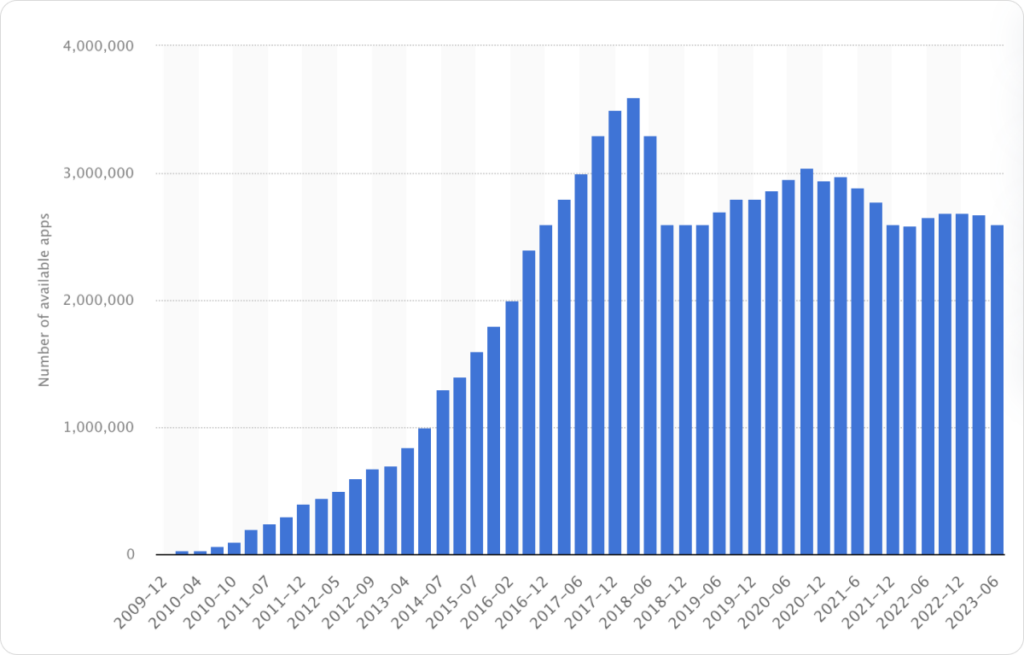In today’s hyper-competitive app market, attracting and retaining mobile app users requires a unique approach that combines both creative efforts and data-driven strategies.
According to analytics service Statista, in 2017, there was a significant increase in the number of applications on Google Play. Nowadays, the quantity of applications has stabilized, but breaking into the top 250 requires a strategy and consistent adherence to it.

But among users, the increase in installations is observed on a constant basis.

With millions of apps competing for attention across various app stores, it is important for developers and marketers to employ effective strategies that not only attract users but also maintain their interest over time. In this article, we will examine key tactics and strategies that will help your mobile application stand out and thrive in the face of stiff competition.
Comprehending the Competitive Landscape: Essential for App Success
The app market is saturated, making it challenging for new and existing apps to gain visibility. To effectively navigate this competitive environment, it is important to understand the market dynamics. Conduct thorough market research to identify your target audience, analyze competitors’ strategies, and identify user issues that your app can solve. In the research, we recommend including the following points:
- Market Research Data: Gather information on the current state of the app market, including the size, growth rate, and major players in your niche. Understand trends, user preferences, and behavior within the market.
- Competitor Analysis: Evaluate your direct and indirect competitors. Look into their app features, pricing strategies, target demographics, user experience, and marketing tactics. Identify their strengths and weaknesses.
- User Demographics and Behavior: Collect data on your target audience. Understand their demographics, preferences, behavior patterns, and pain points. Analyze user reviews, ratings, and feedback on competitor apps to identify common user concerns.
- App Performance Metrics: Gather data on app performance metrics such as downloads, retention rates, active users, engagement metrics (time spent, sessions per user), conversion rates, and churn rates. Compare these metrics with those of your competitors.
- App Store Data and Rankings: Analyze app store rankings, visibility, keywords, and metadata optimization strategies employed by your competitors. Track changes in their positioning over time.
- Marketing Strategies and Campaigns: Study competitor marketing efforts across various channels (social media, ads, influencer partnerships, ASO – App Store Optimization, etc.). Assess the effectiveness of their campaigns and strategies in attracting and retaining users.
- Monetization Strategies: Explore how competitors monetize their apps (freemium, subscription, ads, in-app purchases, etc.). Understand pricing models and how they impact user acquisition and retention.
- Technological Advancements and Innovations: Look for technological advancements or unique features your competitors are introducing. Evaluate their impact on user acquisition and retention rates.
- User Feedback and Reviews: Analyze user feedback and reviews for competitor apps. Understand what users appreciate or dislike about the apps and identify areas for improvement or innovation.
- Customer Support and Service: Evaluate how competitors handle customer support and service. Analyze response times, problem-solving capabilities, and user satisfaction levels.
Keyword Identification and Effective Application Strategies
Use SEO-optimized keywords relevant to your app’s niche in all marketing materials, app descriptions, and website. Conduct keyword research using the Keyapp platform, we previously published an article on the topic How to Gather the Keywords for Your App Using ChatGPT? Best Prompts Practice. This will help you identify high-volume, low-competition keywords that align with your app’s goals. Organically integrate these keywords into your content to improve visibility and attract organic traffic.
Crafting Compelling App Store Listings for User Engagement
- Optimization of App Store and Google Play Metadata. The visibility of your application largely depends on its metadata in the app store. Optimize the application title, description, keywords, and visual elements (such as icons and application screenshots) to create a compelling first impression. Use attractive visual materials that highlight the key features and advantages of the application to attract potential users.
- Stimulating Positive Reviews and Ratings. Positive user reviews and high ratings significantly impact app store rankings and user decisions. Encourage satisfied users to leave reviews by using prompts in the application, offering incentives, or providing exceptional service. Respond promptly to negative feedback to demonstrate responsiveness and commitment to user satisfaction.
- Creating a Strong Social Media Presence. Create engaging content on social platforms that resonate with your target audience. Regularly share updates, user reviews, and insider information to build a community around your application. Engage with users, answer questions, and use hashtags to expand your audience.
- Collaborating with Influential Figures. Partnerships with influential individuals in your application’s niche can significantly expand your audience. Identify influential individuals with an active audience that matches your target group. Collaborate with them to create authentic content, reviews, or educational materials that demonstrate the value of your application.
- Continuous Improvement Based on User Feedback. Regularly seek and analyze user feedback to identify areas for improvement. Implement updates and new features based on user suggestions for continuous improvement of the user experience.
- Personalization and User Engagement. Implement personalized user experiences through individual recommendations, personalized notifications, and in-app messaging. Encourage user engagement by offering exclusive content, rewards, or loyalty programs.
Conclusion
In the face of stiff competition in the app market, a combination of strategic planning, data-driven decision-making, and user-centric approaches is key to effectively attracting and retaining users. By using SEO-optimized content, optimizing app listings in app stores, participating in social media and influencer marketing, and prioritizing user satisfaction, your mobile application can thrive and stand out among competitors.
By applying these tactics and continually adapting to market trends and user preferences, your application can not only attract users in the initial stages but also contribute to long-term loyalty and success in the competitive app environment.






















